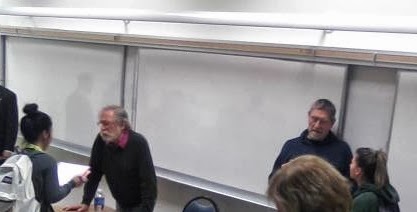"Interaction." "Obsession." "Fortitude." These are the words that echo within the walls of UC Davis's famed ceramics studio, TB-9. Under the tutelage of Robert Arneson, the students of Davis took the longstanding practices of ceramics and metalwork and molded them into new, innovative concepts that would define Ceramic Funk Art of the 1960's. In a rare alignment of the stars, the best group of people met in the best location, to create the best environment for birthing this radical offspring of traditional pottery. The students involved would go on to spread their experiences around the world as artists and teachers of the contemporary world of sculpture. For one night, Steve Kaltenbach, Peter Vandenberge, and Jerry Walburg reunited to reminisce about their old studio in Remembering TB-9, a lecture at Sac State.
After a quick historical overview by Elaine O'Brien, the three emeritus professors of Sac State were asked to tell the audience exactly what made TB-9 so special. Vandenberge recalled being a senior at Sac State and learning about the amazing things happening in Davis's ceramics program. An invitation by Arneson led him to apply to Davis (a city he admits he barely knew about) where he would meet Kaltenbach, Walburg, and the rest of the TB-9 pioneers learning the new perspectives on ceramics taught by Arneson. Walburg noted that to them, the man who would be known as the father of Ceramic Funk Art Movement "was TB-9". Arneson assembled and attracted only those individuals ready and willing to stretch the boundaries of their comfort zones in art.
California Artist
by Robert Arneson
stoneware with glazes
Self Portrait of the man who
started the TB-9 Revolution.
As their methodical takeover of the studio progressed, the students adapted to the unique flow of the classroom that inspired their creativity. Arneson and the other professors were very close to students in their work as well as age (Walburg was only 5 years younger than Arneson). Hostility was rarely an issue, even when Arneson would smash their work and have them put it all back together as a means of teaching them not to get attached to anything. They would be forced to actually think about the purpose of their works and defend them when the time came (or face having it smashed of course). Such a style of teaching is very useful to art students in my opinion, as they must build an intellect of their heads to accompany the intellect of their hands.
House Poet
by Peter Vandenberge
ceramic sculpture
The TB-9 artists left their mark in the Sacramento area.
This sculpture is seen everyday by students in the Sac State Library.
Aside from the professors, the students found each other to be great teachers as well. The studio was never locked because, according to them, there would always be someone working day or night (Arneson especially). The students carried an attitude that supported productivity and motivation. When you place that many creative people in a room together, competition is bound to spring up, but in a good way. Though Kaltenbach admits that on a few occasions, ideas would be "borrowed" rather than shared, they held an outlook of generosity with one another. The students wanted each other to succeed, and in the end, there can be no better creative motivation than support from the people you care about.
Indo-Arch
by Jerry Walburg
bronze sculpture
Walburg's innovative designs become a
part of the Sacramento community.
Time to Cast Away Stones
by Steve Kaltenbach
fountain sculpture
An intense combination of
portraits, including Arneson himself.
As the discussion concluded, the three TB-9 alumni gave their opinions on what they learned in the studio that young artists should walk away with today as well. Vandenberge valued the interactions he had with the creative minds around him. Kaltenbach prized an artistic obsession that kept him from stopping at any time. And Walburg viewed fortitude as the key to surviving both the unique atmosphere of TB-9 and the art field in general. Together, these individuals sought after an escape from convention to give life to the Ceramic Funk Movement, knowing full well the risks involved. But as history has shown us, it is the artists who refused to conform who are ultimately remembered the most. The legacy of TB-9 would be nonexistent if not for this extraordinary group of revolutionary minds.
Remembering TB-9: Steve Kaltenbach, Peter Vandenberge, and Jerry Walburg in Conversation.
Lecture at CSUS in Mendocino Hall.
Mar. 6, 2014. 6-7:30 pm.








This is a very nice piece on the TB-9 event, Ricardo.
ReplyDelete